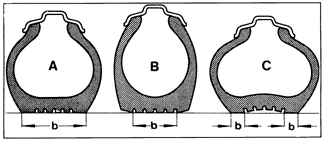Tire WearTire tread wear, while not a source of immediate feedback, can be an indicator of suspension and steering problems. Proper tire tread wear is difficult to notice, so tires are made with wear indicator bars which visually indicate when the tire is nearly worn-out. These wear indicator bars show up as evenly spaced bald "stripes" running across the tread surface, as shown in Fig. 3-1.

Uneven tire wear usually indicates improper tire inflation pressures or a misalignment condition. Fig. 3-2 illustrates how tire inflation pressures influence tire wear. Tire wear that is uneven across the tread-one side worn more than the other or unusual wear of individual tread blocks-probably indicates an alignment problem. Cupping or scalloping-wear that is uneven around the circumference of the tire-is a telltale sign of a tire balance problem or a worn-out shock absorber.

|